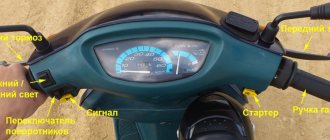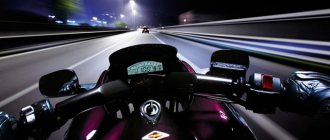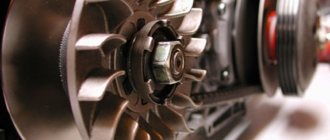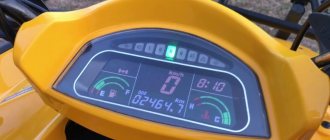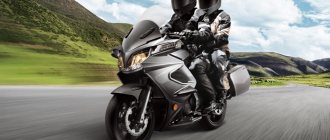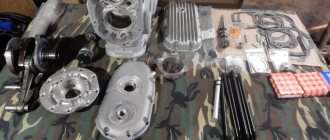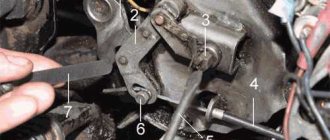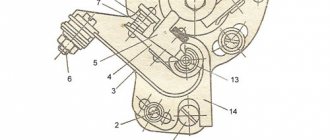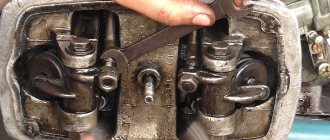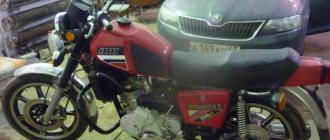Driving in particularly difficult areas
The air pressure in the tires should be reduced to the required values, which correspond to better maneuverability on a particular road section. The transfer case differential is blocked, since towing the drive wheel pair in conditions of loss of movement or slipping with a locked differential causes intense wear on the differential of the box. Tires also wear out.
You need to move the truck, repeat gear shifting to move forward and backward if it is difficult to engage or disengage the differential lock, or change speed modes. It is worth locking the cross-axle differential of the rear axle if you are driving through a difficult section of the road where there is a risk of slipping.
Locking should be done when the vehicle is completely stopped (the wheels are stationary). Blocking of the small forest differential in driving conditions is allowed at a speed of 30 km/h, no more (provided there is no wheel slip).
Make sure that the locking mechanism is fully engaged after the locking valve has been turned on. A lighted warning light will help you find out for sure. If the locking mechanism is not fully engaged, this may cause gearbox failure.
As soon as the difficult section of the road is left behind, you should turn the rear axle differential lock valve to the “Off” position. The indicator should go off, which confirms the off position and the clutch is disconnected.
Moving with a trailer and semi-trailer
To ensure the functionality of the towing device, use a coupling loop with an internal diameter of 90 mm, its cross-sectional size is 42 mmg, the parameters of the towing hook are: throat diameter 48 mm, width in the throat area 69 mm. Possible largest dimensions: loop section 38 mm, hook width 66 mm, hook mouth 52 mm.
During the maneuver, avoid the possibility of folding the trailer all the way into the end of the frame side member or other elements of the trailer tongue machine. This could cause the trailer eye to become jammed in the towbar opening, causing the towbar to break.
When passing particularly difficult sections, disconnect the trailer, and after passing the section, winch it to the car. Remember that there should be three or four turns on the drum. Pull the trailer at medium engine speed. Do not tow a trailer with a winch cable.
When passing difficult sections of the road with a Ural: 43203-10 or 43203-31 with a trailer (or during a maneuver), do not allow the spare wheel and its holder to come into contact with the trailer.
Remember that in difficult road conditions, the road train moves well when the tractor and semi-trailer in the horizontal plane do not have a folding angle or this angle is very small. If the folding angle increases, then a lateral force begins to act. It tends to cause the tractor to slide sideways or overturn it.
When driving with the auxiliary brake activated on a slippery surface with a low coefficient of adhesion and the absence of a solenoid valve for the brake system on trailers, the trailer may fold and skid.
Source
ENGINE
Cars of the new model range are equipped with modifications of the new YaMZ-536 engine with a power of up to 312 hp. The new modernized engine is characterized by increased reliability, increased service life and improved fuel efficiency.
| engine's type | Row | ||
| Number of cylinders | L-6 | ||
| Engine capacity. L | 6,65 | ||
| Power, hp | 240 | 285 | 312 |
| Max. torque, N.m (kgf.m) | 900 | 1130 | 1226 |
| Environmental class | EURO 4 |
ADVANTAGES OF YAMZ-536 SERIES ENGINES
- Compact and light weight;
- High reliability (lifetime up to 1 million km, service interval 15 thousand km. Accordingly, reduction in engine maintenance costs by 1.5-2 times);
- Low noise and vibration levels;
- Low fuel consumption;
- Ease of maintenance of internal combustion engines.
- In-line arrangement of engine cylinders;
- Common Rail fuel injection system Bosch (Germany);
- Euro 4 engine without AD-Blue (urea).
Third day (August 12)
Early morning. At around 06:00 we arrive in the village. Inta to expect the all-terrain vehicle. At first slowly, then much faster, we collect our things and enthusiastically go to watch the diesel locomotive start moving... It’s not very cool, it just went. Moving to the station, we are met by a pleasant-looking man. It was Vladimir, our guide. (Vladimir Zhiravin, you can contact us by phone 8-912-558-16-76 (mobile, MTS). He can also take care of issuing passes to the national park for you. You just need to call in advance. - Ed.) We are moving to the car, it turns out to be a Ural with a 6x6 formula, quite standard, with a booth as a body. The weather was cloudy, but what will it be like at 06:00?? First of all, Egor and I climb into the cabin, then I understand that there are not enough of us, and we will not pay 9, but 12,000 rubles. This was a little upsetting. (Then we agreed with Vladimir at 10500 - editor's note.) The asphalt ended 200 meters from the station... Then there was a dirt road, quite broken down in places. After some time, we change with the girls and go to the “body” and off we go, in the back there was a dog and a fellow traveler, Sergei. Sergei was a little drunk and asleep. The dog was sober, but could not stand on his feet... No one could stand on his feet there. Sergei told us some “little tips” and a couple of vulgar jokes and got off at the river crossing. Skin. There were four of us traveling further. When we were riding in the cab, we talked with the driver about bicycles and bears, and when we were riding “from behind,” we were flying all over the body, desperately trying to hold on. After a few hours I felt worse, I thought that my insides were mixed up, and I would now lay out some of them. Later it became better and more fun. The car impressed with its cross-country ability, since even the impact of the bridge on a boulder did not cause anything other than my fear. The whole time we were driving, I continually admired what I was seeing - very beautiful nature, beautiful terrain, beautiful mountains, it’s impossible to describe in words. Upon arrival at the place, we were immediately attacked by small flies, there were unrealistically many of them... We began to assemble the frame for the catamaran and set up camp. (GPS coordinates: N65'20.218, E060'43.805) In the evening the flies were replaced by mosquitoes, but 70% of the composition. We've almost finished the frame, there's just a little bit left. The only problem is that there is nothing to collect it from. and overall everything is fine. Tomorrow we must sail...
Authors: Maria Sokolova, Egor Voronin, Olga Soboleva, Dmitry Bondarevsky
Only forward, not a step back: test drive Ural-4320
Eternal soldier of Russia
And more precisely, also the Soviet Union. And it all started in 1961, when the Ural Automobile Plant, located in Miass, pleased the army, but even more so the oil workers and refiners with its Ural-375D car. This vehicle very quickly received the telling name “Glutton”: the truck could gobble up 50-70 liters of fuel per hundred kilometers. Moreover, not diesel fuel: its eight-cylinder, seven-liter engine was gasoline. In general, the military respects diesel more, but there is also a relatively small resource, gasoline, and an enormous appetite... It was necessary to do something with this car, and first of all, change the power unit. This is how the diesel Ural-5320 appeared.
This was in 1975, but until 1992 the Ural-375D was never taken out of production, especially since it still had some advantage over the new car: the cross-country ability of the previous car was slightly higher. Mainly due to the fact that its gasoline engine was not equipped with a fuel pump speed controller, which was installed on the diesel Ural. The Ural-375D could drive at minimum speeds off-road, and its successor, under the same conditions, tried to independently increase the fuel supply and turn the wheel in the mud - even though it was a diesel engine! Nevertheless, the Ural-4320 eventually replaced its gasoline predecessor in the army.
However, the “conscription commission” did not recognize the recruit fit for service so quickly. The first attempts to recruit diesel into the ranks of the army did not have much success: the Ural-640 engine, which they tried to make friends with the Ural-375, turned out to be unreliable, and it was decided to build a completely different Ural, for which the Yaroslavl Motor Plant was ordered to design a new diesel power plant unit. A new gearbox was also required, so since 1969, designers sat down at the drawing boards with the goal of not just modernizing an existing car, but making an almost new car.
Although the Ural-4320 turned out to be similar in appearance to the Ural-375D, it is quite structurally different from it. Since 1977, the power unit of the Ural-4320 was the KamAZ-740 engine, but after a fire at the plant in 1993, the Ural returned to YaMZ engines, and now there are two of them: the six-cylinder YaMZ-236NE2 and the eight-cylinder YaMZ-238. The car we are going to look at today is equipped with an eight-cylinder V-twin engine. Its power is 240 hp, volume is 10.85 liters. In general, there is something to see.
Find five differences
For most normal people, the Ural is a large vehicle with six wheels, but not a ZIL or a KrAZ (if anyone still remembers the latter). But based on some details of the Urals, you can approximately determine the age of the car and the type of engine under the hood. Such knowledge will probably not bring practical benefit, but if necessary, you can show off beautifully in front of your friends. That's why we tell you.
If the “face” of the Urals is not too elongated, then this is a car produced before 2000, and under the hood it has a six-cylinder diesel engine YaMZ-236NE2 (after 2000, all Urals were produced with a long hood). If there is no air filter on the right side of the wing, then the engine is different, namely KamAZ-740, and the car is also more than 15 years old. Well, the Ural with a new cabin, produced after 2009, can be distinguished immediately: it no longer resembles a normal Ural, it does not evoke reverent delight, as well as horror and respect. Our car is another matter: the Ural in all its masculine glory. Let's take a closer look at it.
The long nose is not only a consequence of the fact that somewhere it was necessary to fit an impressively sized engine. The fact is that immediately behind the grille there is a pair of oil radiators. Under the bumper there is a bracket, by stepping on which you can climb onto the bumper in order to open the hood. It’s interesting to see what the V8 of the Urals looks like.
Well, as expected, the generator is located at the very top, the air intake is located above the wing. You can safely climb into a ford up to one meter deep, you just need to close the radiator blinds. But you shouldn’t go to the maximum depth that the Urals can overcome (up to 1.7 m “taking into account the waves” - that’s what the instructions say) without some preparations. However, it doesn’t take too long to disconnect the fan clutch, make sure the batteries are sealed (there are two of them) and close the exhaust pipe with a special ford valve.
There is a device under the hood that should ensure the engine starts in cold weather. Access to the “control panel” is quite convenient. Let's see what we can click here.
We turn on the pump with one toggle switch, then the electric heating of the coolant. The colder it is outside, the longer the heating turn on time. Then we start the heater boiler and wait until the engine warms up. After this, the system can be turned off and the engine can be started in the usual way. In reality, this is a little more difficult than it seems, but you can do the job. As a result, the Ural can be started even in severe frost, minus 30, however, all these operations will have to be carried out in this same frost. We will tell you below how to start the engine easier.
While getting onto the bumper is quite easy, getting off is a little more difficult. It’s easier to jump off the bumper (from it to the ground - a little less than a meter) than to find this bracket, along which the designers suggested climbing and descending. You can’t see it from above, and you won’t be able to feel it with your foot right away.
The last thing we will pay attention to during the external inspection is the wheels of the truck. A military truck cannot do without a centralized pumping system. However, in civilian life such a thing will not be superfluous, given that the Ural is not only a truck, but also an all-terrain vehicle. Unfortunately, we only have to ride on asphalt. Well, then we climb into the cabin and see how the driver feels behind the wheel in this far from small car.
Something new!
We open the driver's door and immediately at eye level we see a very good seat adjustment system. It can not only be moved forward and backward, but also raised or lowered or changed the angle of inclination. Of course, the adjustments are mechanical, but the design seems to say: “Don’t mess with it, you’ll be tortured to turn it.” We won’t touch them, we’ll sit down like this, right away. Our car is from 2007, and it’s also used for driving lessons, but the cabin looks new. And this is understandable: there is less plastic here than Leonardo DiCaprio’s Oscars, and metal and rubber are hard to wear out in eight years. Unlike many truck cabs, which are called three-seaters only on paper, this one is really spacious. Of course, the passenger will have to be careful not to catch his feet on the gearbox and transfer case levers, but this is still better than parodying sprat in a tin can.
First of all, we check the handle on the panel, elegantly called by the designers the “manual engine stop” handle. Then close the radiator shutter (if it is open) and do not forget to press the power button. Now you can start the engine. Even after three days of parking, it starts up with half a turn, and the sound makes it happy: the 11-liter engine runs smoothly and is not too noisy. But nowhere else have I heard such a sound from a windshield wiper motor. It amused me, but didn’t upset me: it’s not a passenger car, so I can bear with it. Well, it's time to go!
Ural on the move
First, let's look around how to get out of the parking lot. At first glance, the review is quite good. Depress the clutch and engage second gear. The engine pretends that almost ten tons of the car’s weight are like seeds for it, and the Ural starts moving. The steering is equipped with a hydraulic booster, but this is not at all like on your Toyotas and Volkswagens. You can’t turn the steering wheel with your finger, and you can only turn the steering wheel with one hand while moving. Due to the decent width of the cabin, you constantly want to move a little to the right, but the thought that the distance between the extreme points of the side rear-view mirrors is almost three meters forces you to return to your lane. The pedal assembly turned out to be unexpectedly convenient: the distance between the pedals and their travel are just such that it’s easy to press on them, and you don’t have to work too actively with your feet. As far as foot control is concerned, the horn switch was a source of criticism. They managed to hide it so cleverly that it is almost impossible to find it right away. If there is a need to honk, you will have to remove your foot from the clutch pedal, which is not always convenient during maneuvering. Why it was impossible to make a separate electric signal with a button on the steering wheel is a question.
Since we are talking about maneuvering, let’s dwell on this in more detail. The declared speed of 85 km/h on the Ural chassis is easily achieved, and you can even enjoy the ride. But turning around and making more precise maneuvers is not an easy thing. And it’s not only the decent size of the truck (you can get used to this), but also the heaviness of the steering. At low speeds, the power steering is not very effective, although, of course, it does its job. With a little care, you can quite accurately determine the dimensions of the car. But when reversing, difficulties arose with visibility in the rear-view mirrors. They are large and should theoretically be enough for driving. And yet, determining the dimensions of the rear of the car turned out to be very difficult. I can partly justify this shortcoming by not adjusting the mirrors very precisely to my parameters, but on all other cars, and even on buses, it was not such a problem for me to determine where the rear of the car was going and what it was about to drive into. It somehow didn’t work out with the Urals - it’s good that there was no one behind. In general, you need to be careful.
The long front overhang can interfere with determining the dimensions when turning: the front axle is located exactly in the middle between the driver and the front bumper. The decent drift of the Ural’s “face” when turning has to be taken into account, especially if you need to fit along a precise trajectory into a narrow path. However, if there are no serious problems with the cerebellum, then you can cope with the control of the Urals.
The brakes work effectively, but when the car is empty, their response is unnecessarily sharp. With a full load (the Ural is capable of carrying up to ten tons of cargo), most likely, everything will fall into place. However, the force on the brake pedal must be measured carefully.
All that remains is to turn off the engine correctly. To do this, we use the engine stop handle (oh, who came up with this name?). We wait a minute - the engine should idle - then we pull it towards ourselves. That's it, we've arrived.
For all occasions
The Urals deservedly deserves respect. In terms of cross-country ability, it leaves behind its main army rival ZIL-131 and the more modern ZIL-4334. It is quite convenient and reliable, the only negative is that it is still very gluttonous. In a mixed cycle, he rarely manages to meet the required 40 liters per hundred kilometers, and on off-road conditions, even fifty liters of fuel may not be enough for a hundred kilometers. Therefore, the tanks are appropriate: 300 liters main and 60 liters additional. True, on the highway it is much more economical than its predecessor, and these figures are not so scary, if you do not forget about how much this truck can drag on itself, especially off-road. Now a whole line of modifications of the Ural-4320 is being produced, including two-axle vehicles and even armored vehicles Ural-4320-09-31 and Ural-E4320D-3. Urals are also quite willingly exported, which, in general, is a rarity for our automobile industry.
Source
iffGeniy1311 › Blog › Training for category “C”
I went to study for category “C” at DOSAFF (where I studied for “B”, they didn’t teach trucks, alas), and almost immediately signed up to drive. They train on the URAL-4320, which is no less than 30 years old. Due to the lack of a site (autodrome) in Ruzaevka and my driving skills, the instructor conducted the first driving on a country road, leaving the city towards “Suzgar”. The route I covered on the first day will be shown in the photo:
Of course, after the 7th round, driving a Ural is something different, but interesting. Previously, I drove a GAZ-53, and drove a KAMAZ, and drove tractors (while I worked as an assistant combine operator while a school student) and, as a result of the same work, drove a combine harvester (I had an Acros 530). But I drove all this along a cross-country road, in a field, where there was no fear of encounters with other cars. In the Urals, we had to quickly adapt to the dimensions of the car. So everything is fine, but controlling the starboard side is problematic due to the shaking (even dangling) stand with mirrors. Having passed the suburban part of the route, we began to enter Khimmash. I expected the instructor to get behind the wheel himself, but in response to my question “will you get behind the wheel here?”, I suddenly heard “no, go ahead.” In general, there was no problem with this, but there was a small snag - while driving along the highway, I almost didn’t use the brakes and my leg “didn’t remember” the moment they were activated. Everything would be fine, but either because of old age, or because of the very design of the brake system, the braking on this crane machine is inert or something - the brakes engage with a very large delay, indeed with a very large delay. Plus, the pedals are hellishly tight))) This was somewhat annoying when driving around the city, where there are a lot of cars, as well as pedestrian crossings and people who DO NOT walk on them, but climb anywhere) The car is such that it is more than 55- It was impossible to drive it at 60 km/h even on the highway; in the city, of course, for safety reasons, I drove more slowly. I would like to apologize to everyone I detained on January 5 from 10:00 to 10:30 (approximately) while I was moving from Khimmash towards Ruzaevka along the street. Lunacharskogo to st. Mayakovsky 102, as well as yesterday (January 11th) from 17:10 to 17:30 on the same route
. There’s nothing to be done, this car simply doesn’t go uphill at more than 30-35 km/h, and I was careful myself, since I haven’t really driven this car yet...
Source
